Twinkling cityscapes, fog-draped redwood groves, golden beaches, a vibrant food culture, and a spirit of adventure—California grabs your attention from the start.
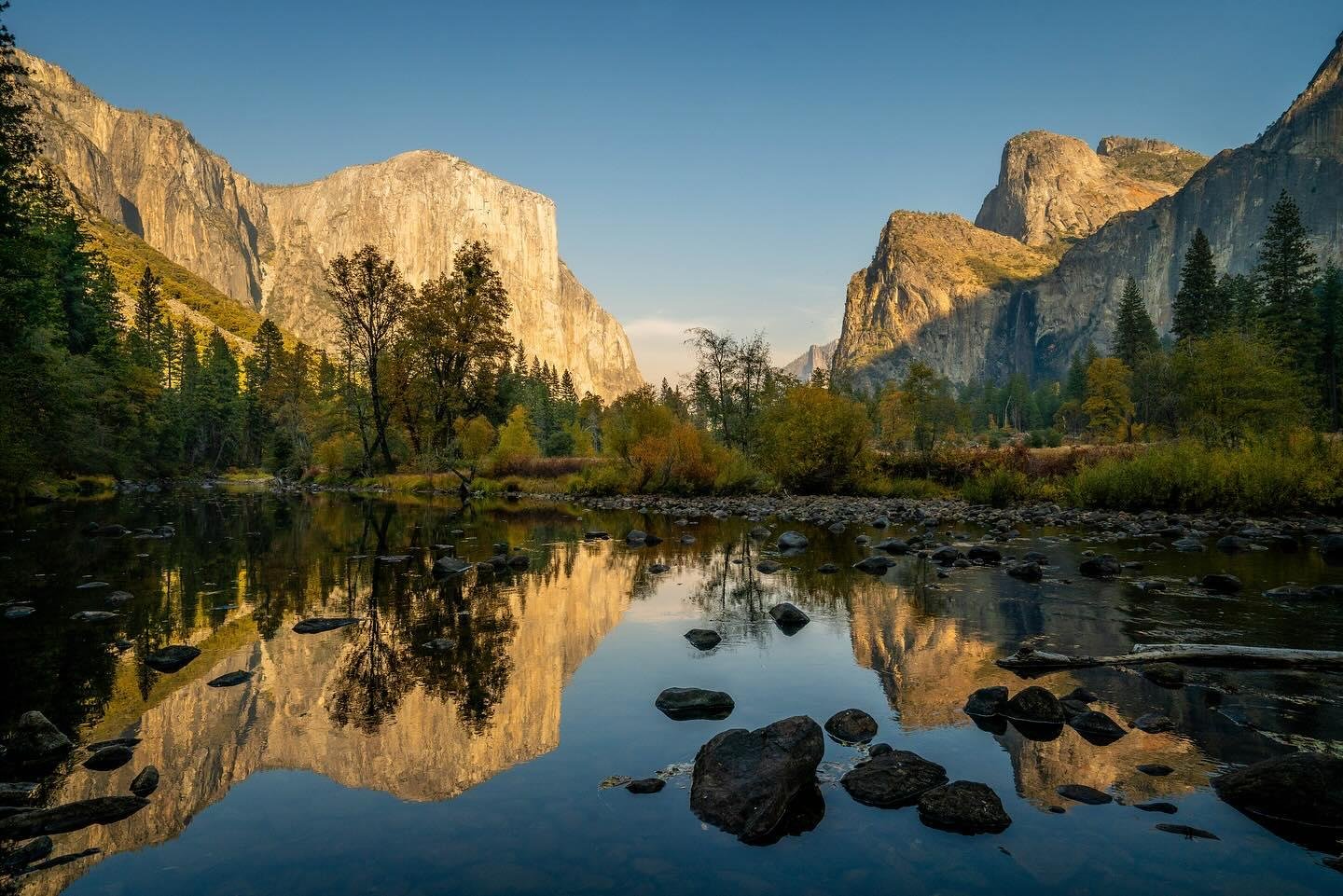
Yosemite, whose name means “killer” in the Miwok language, is a breathtaking blend of soaring granite domes, thunderous waterfalls, serene meadows, and glassy lakes. It stands as one of America’s most iconic national parks, attracting over 5 million visitors yearly to marvel at landmarks like Half Dome, El Capitan, Mariposa Grove, and Yosemite Falls.
The park is a playground for adventurers and nature lovers alike. Over 800 miles of trails range from gentle valley walks to challenging backcountry hikes. Rock climbers from around the world test their skills on El Capitan’s sheer granite face, while slacklining—a sport born here—offers new ways to connect with the outdoors. Horseback riding, rafting, skiing, fishing, and even hang gliding add to the year-round excitement.
Must-See Views & Attractions
Tunnel View: The quintessential Yosemite Valley panorama featuring El Capitan, Bridalveil Fall, and Half Dome.
Valley View: A peaceful riverside spot perfect for a farewell glance at Yosemite’s grandeur.
Glacier Point: A lofty 3,200-foot viewpoint offering stunning vistas of Half Dome and the valley below.
Yosemite Falls: One of the tallest waterfalls in North America, dazzling visitors with its power and seasonal transformations.
Bridalveil Fall: Known as Pohono, the “Spirit of the Puffing Wind,” this graceful waterfall flows nearly year-round.
Tuolumne Meadows: A cool, wildflower-strewn alpine paradise far above the valley floor, ideal for hiking and relaxation.
Historic & Cultural Highlights
Yosemite’s preservation owes much to naturalist John Muir, whose writings helped establish it as a national park in 1890. The Ahwahneechee people, indigenous to the valley for millennia, imbued the landscape with cultural significance. The Majestic Yosemite Hotel, a historic architectural gem, invites visitors to relax amid grandeur and history.
Activities & Amenities
From family-friendly campgrounds and equipment rentals to lively evening programs, Yosemite caters to all visitors. Whether you’re enjoying a leisurely stroll to Lower Yosemite Fall, taking a guided tram tour, or watching climbers scale El Capitan, the park’s facilities and activities ensure a memorable stay.
Planning Your Visit
Entry costs $35 per vehicle, with various guided tours available, including eco-friendly options and multi-day backpacking adventures. Popular tour operators include Yosemite Conservancy, Sierra Club, and Tenaya Lodge, among others.
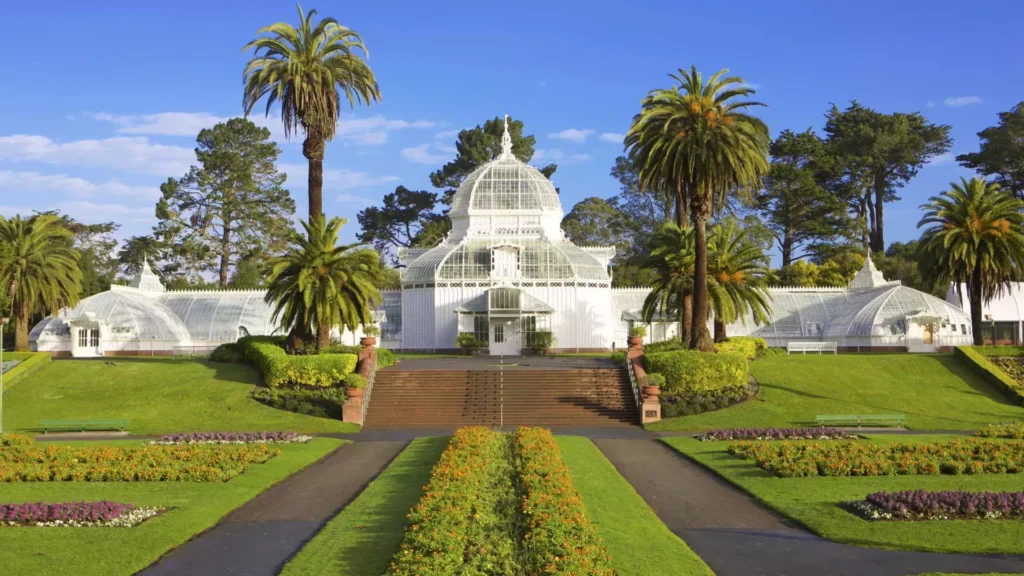
When Frederick Law Olmsted, the famed designer of New York’s Central Park, first laid eyes in 1865 on the piece of land that San Francisco Mayor Frank McCoppin envisioned transforming into a vast city park, he was understandably doubtful. The site was a stretch of 1,013 acres of unattractive, shifting sand dunes on the city’s outskirts, constantly battered by strong winds from the grey Pacific Ocean. Olmsted declined the opportunity to create a park larger than New York’s Central Park before his own iconic project was even complete.
However, a century later, Olmsted would likely smile at the transformation Golden Gate Park had undergone—from bonsai trees, buffalo, and redwoods to Frisbees, free concerts, and a hub for free spirits during the 1960s Summer of Love. Today, the park still captures much of what San Franciscans cherish about their city.
You could spend a week exploring Golden Gate Park and still not see everything. Every visit offers a stroll through San Francisco’s history, from the park’s oldest sections in the east to its western edge that meets the Pacific surf.
Golden Gate Park was the vision of several local politicians eager to convert former Mexican territory on San Francisco’s outskirts into valuable city land. Among them, Mayor Frank McCoppin saw a chance to not only give residents more space but also resolve disputes with affluent squatters who had laid claim to the so-called Outside Lands.
Despite Olmsted’s doubts about the site’s suitability for a park larger than Central Park, ambitious civil engineer William Hammond Hall and master gardener John McLaren set to work. They imagined a natural sanctuary free of commercial distractions such as casinos and racetracks, a bold and unusual idea in an era when Central Park itself was still unfinished and national parks like Yellowstone were yet to be established.
McCoppin, Hall, and McLaren’s efforts resulted in a park that feels wild, tangled, and maze-like, as historian Gary Kamiya describes it in Cool Grey City of Love: 49 Views of San Francisco. Its apparent naturalness is in fact almost entirely crafted by human hands. The loss of the original sand dunes is lamentable, but the park stands as a remarkable example of man negotiating with nature.
Many of the park’s earliest landmarks attest to this achievement. The Conservatory of Flowers, opened in 1879, houses rare plants from the Americas and Amazonian aquatic species. Stow Lake, created in 1893, features the picturesque Strawberry Hill and has been a family favorite for over a century.
The Japanese Tea Garden, the oldest public Japanese garden in the U.S., dates back to the 1894 California Midwinter International Exposition. It features carefully cultivated plants, birds, and fish imported from Japan, thriving in what was once inhospitable land.
After the 1906 earthquake devastated San Francisco, thousands of refugees camped in parks, including Golden Gate Park, where army-built shacks were later converted into permanent homes still in use today.
As San Francisco rebuilt, institutions like Kezar Stadium, the California Academy of Sciences, and the de Young Museum made the park their home. The iconic Windmills, built in 1903 and 1908, frame the park, while the Dahlia Garden and Shakespeare Garden, featuring plants mentioned in the Bard’s works, appeared in the 1920s.
During the Great Depression, the Works Progress Administration enhanced Golden Gate Park with new features like the San Francisco Botanical Garden, archery fields, Anglers Lodge, and the Model Yacht Club. They restored the Horseshoe Pits and built the Beach Chalet, adorned with frescoes that tell the park’s story.
The Hoover Grove, planted in 1930 with giant sequoias to honor World War I casualties, offers visitors a chance to see towering trees without leaving the city.
The park’s role continued to evolve. The Stow Lake boathouse was added in 1946. In the late 1960s, the Panhandle area near Haight-Ashbury hosted the Human Be-In, igniting the Summer of Love, drawing thousands of youths to Hippie Hill for free music and communal gatherings fueled by countercultural ideals. Even today, visits to Golden Gate Park around April 20th evoke the spirit of those times.
One of the newest landmarks is the National AIDS Memorial Grove, established in 1991 to honor those lost during the AIDS crisis that deeply affected San Francisco’s LGBTQ+ community.
Golden Gate Park remains a vibrant, changing space hosting events like the Bay to Breakers 12K race and annual music festivals such as Hardly Strictly Bluegrass and Outside Lands. During the holiday season, families flock to enjoy festive Christmas lights.
In 2020, the park celebrated its 150th anniversary with temporary art installations like Charles Gadeken’s Entwined light show in Peacock Meadow and the SkyStar Wheel, a Ferris wheel set to remain through March 2025. That same year, protestors toppled several historic statues in the park during Juneteenth demonstrations.
The COVID-19 pandemic inspired new uses of the park as well, including the weekly Sunday Roller Disco Party near 6th Avenue and Kennedy Drive, featuring live DJs. During summer months, visitors can find 12 pianos hidden throughout the Botanical Garden as part of the Flower Piano event, which offers free piano lessons and community sing-alongs.
Spanning over three miles long and half a mile wide, Golden Gate Park offers numerous entrances. The most popular is at the Panhandle via Fell Street, while the 9th Avenue entrance near Lincoln provides close access to many attractions.
Main roads like JFK Drive, Transverse Drive, Chain of Lakes Drive, and 25th Avenue offer vehicle access, though some streets are closed under the city’s Slow Streets program to encourage walking and biking during the pandemic. Check the park’s website for current road closures and event updates.
Walking, biking, and skating are all popular ways to explore the park, which is served by several bus and trolley routes around its perimeter. The park remains open 24/7, with restrooms available throughout.
Golden Gate Park offers over 4,700 street parking spots and accessible parking at locations like McLaren Lodge, Music Concourse, MLK Drive, and JFK/Transverse Drive. The 800-space Music Concourse garage, open daily from 7 AM to 7 PM, serves major attractions like the SkyStar Wheel, the de Young Museum, several gardens, and the California Academy of Sciences.
A free shuttle operates on weekends and city holidays from 9 AM to 6 PM, running every 15 to 20 minutes to help visitors get around.
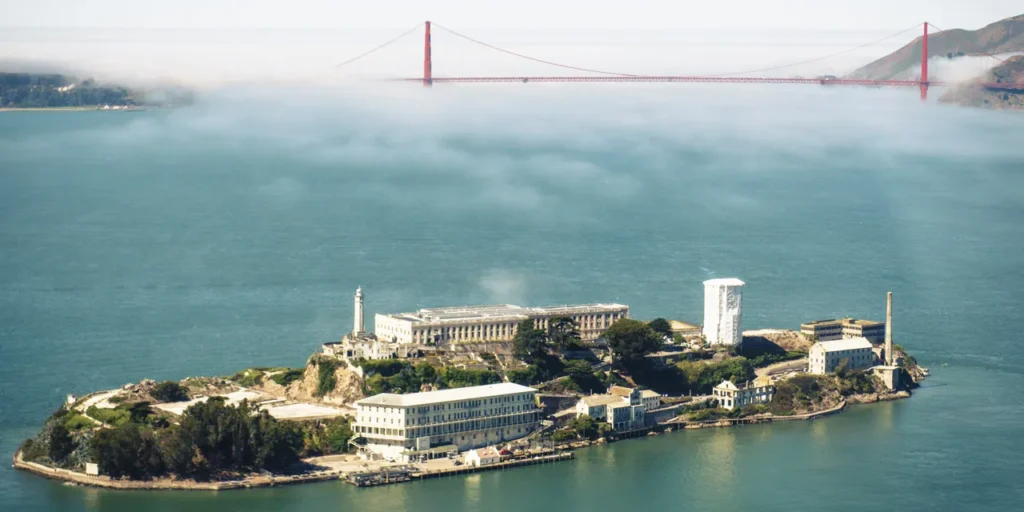
For more than 150 years, the name has sent chills down the spines of the innocent and caused cold sweats for the guilty. Over time, it has served as a military prison, a notorious maximum-security penitentiary, and a contested site between Native American activists and the FBI. No wonder the moment you set foot on “The Rock,” it feels like the opening notes of a suspenseful soundtrack: dunh-dunh-dunnnnh!
It’s also no surprise that Alcatraz draws about 1.4 million visitors annually. With its close proximity to a major city, a fascinating and unexpected history, and breathtaking views of the San Francisco skyline, the island remains one of the most popular national parks in the United States. Yet, for much of its history, Alcatraz was a place where people labored desperately to escape — not a spot to relax and spend time with family.
The story began innocently enough in 1775 when Spanish Lieutenant Juan Manuel de Ayala sailed the San Carlos past a 22-acre island he named Isla de Alcatraces (Island of the Pelicans). In 1859, Alcatraz became the site of the first U.S. fort on the West Coast and soon served as a detention center for Civil War deserters, insubordinates, and court-martialed soldiers.
Among its inmates were Native American scouts and “unfriendlies,” including 19 Hopi who resisted sending their children to government boarding schools where their language and religion were forbidden and punishable by beatings. By 1902, the wooden cell blocks had become decrepit and unsanitary, unable to handle an increasing number of U.S. soldiers convicted of war crimes during the Philippines campaign. A new concrete military prison was constructed in 1909, but maintenance costs were high, and the nation soon turned its focus to World War I, economic struggles, and the flapper era.
When Prohibition began in 1922, alcohol sales were outlawed, but the rebellious Jazz Age culture wasn’t ready to give up their drinks. Gangsters continued to supply liquor illegally, prompting authorities to crack down. In 1934, the Federal Bureau of Prisons took over Alcatraz to showcase its efforts against crime.
Though “The Rock” held an average of just 264 prisoners, its roster read like a who’s who of America’s most notorious criminals. Inmates included Chicago mob boss Al “Scarface” Capone, infamous kidnapper George “Machine Gun” Kelly, Harlem gangster and occasional poet “Bumpy” Johnson, and Morton Sobell, convicted Soviet spy alongside Julius and Ethel Rosenberg.
One of the most famous prisoners was Robert Franklin Stroud, known as the Birdman for his passion for studying and caring for birds during solitary confinement at Leavenworth before arriving at Alcatraz. His story inspired the 1962 film The Birdman of Alcatraz, starring Burt Lancaster. The prison also witnessed the infamous 1946 “Battle of Alcatraz,” a deadly failed escape attempt by inmate Bernard Coy and others.
Today, visitors can experience firsthand accounts of life inside Alcatraz through the acclaimed audio tour offered by Alcatraz Cruises. Yet, stepping outside and hearing the sounds of lively San Francisco across the water, you can understand why prisoners risked dangerous escapes through treacherous waters. Although long considered escape-proof, in 1962, the Anglin brothers and Frank Morris famously vanished on a homemade raft and were never found. High costs for security and upkeep led to the prison’s closure in 1963, leaving the island to the birds.
In the 1960s, Native American activists claimed the island as sovereign land, noting that the Ohlone people had historically used Alcatraz as a spiritual refuge. When the federal government rejected their request to transform the island into a Native American study center, 79 activists from the group Indians of All Tribes (IOAT) occupied Alcatraz on the eve of Thanksgiving 1969.
Over the next 19 months, thousands of Native Americans and supporters joined the occupation, demanding the return of abandoned federal lands to Indigenous tribes as per the Treaty of Fort Laramie. They also called for an end to oppressive policies like Indian Termination and abusive boarding schools that stripped away tribal sovereignty.
The movement broadcasted their message through Radio Free Alcatraz, hosted by Santee Sioux John Trudell, reaching audiences via western radio networks. Public support grew, attracting figures such as Jane Fonda and the band Creedence Clearwater Revival. Inspired by Alcatraz, similar occupations took place nationwide, including the historic Wounded Knee protest in South Dakota. However, ongoing FBI surveillance and the eventual shutdown of water, electricity, and telephone access weakened the occupation.
After the federal government removed the last activists and regained control, the island was transferred to the National Park Service. By 1973, Alcatraz had become a major tourist destination. Today, visitors encounter the cell blocks, “This Is Indian Land” graffiti on the water tower, and rare wildlife as part of the experience. Since 1975, an “Un-Thanksgiving” ceremony is held every Thanksgiving morning, where Native leaders and allies reaffirm their commitment to reversing colonial history.
Alcatraz is open daily except on Christmas, Thanksgiving, and New Year’s Day. Because it is a popular attraction, especially during peak seasons, purchasing tickets in advance is highly recommended. Access to the island is by ferry from Piers 31-33 in downtown San Francisco, with ticket prices covering both transportation and admission.
Day tours start at $25 for children, $41 for adults, and $38.65 for seniors. Family packages for two adults and two children are available for $119.60. Additional options include night tours, Behind the Scenes tours, and combination tours that include Angel Island.
For reservations, call (415) 981-ROCK or visit www.alcatrazcruises.com.
Interpretive materials in braille and American Sign Language are available for visually impaired and deaf visitors, along with assistive listening devices and tactile markers throughout major sites. Close-captioning is provided on film exhibits. An accessible tram helps those with mobility challenges navigate the island once they arrive.
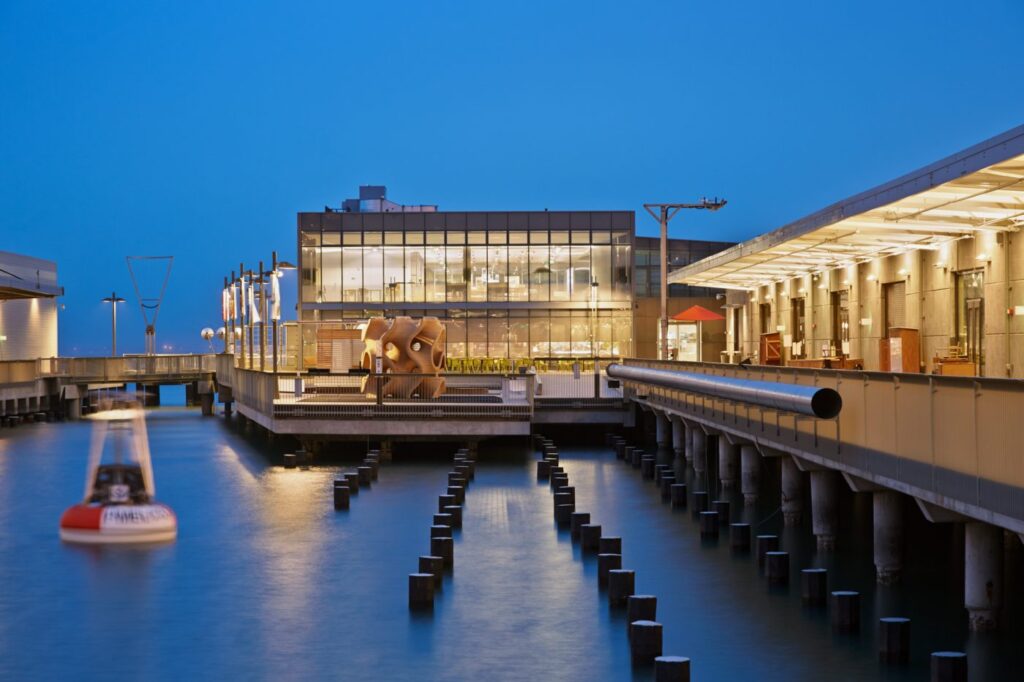
Is there really a science behind skateboarding? Do toilets really flush counterclockwise down under in Australia? At the Exploratorium, San Francisco’s interactive science museum, you’ll uncover fascinating answers to questions you wish you learned in school.
Set on a stunning 9-acre glass-walled pier jutting into the San Francisco Bay, the Exploratorium blends science and art to challenge how you perceive the world. With over 600 hands-on exhibits spread across 330,000 square feet of indoor and outdoor space, visitors of all ages can experiment with color, sound, light, motion, and more — all designed by artists and scientists to spark curiosity and learning.
Highlights include:
The Bernard and Barbro Osher Gallery, exploring human behavior and social phenomena through playful experiments.
The famous Tactile Dome, a pitch-black labyrinth where you navigate by touch alone (reservation and extra ticket required).
The Tinkering Gallery, where young inventors build and experiment with circuits and moving sculptures.
The Bechtel Gallery, a world of reflections, light, and color — try your hand painting with soap films or stepping into a room without color.
The Living Systems Gallery, featuring the tiniest lifeforms and natural wonders under microscopes.
Outdoor exhibits demonstrating the science of San Francisco’s winds, tides, and earthquakes, including an Aeolian Harp and epic bike-part jump rope machine.
The Fisher Bay Observatory Gallery, where real-time data from the bay and surrounding landscapes invites you to explore geology, weather, and environmental change.
Plan Your Visit
The Exploratorium reopens July 1st with new hours (Wednesday–Saturday 10 AM–5 PM, Sunday noon–5 PM; closed Monday–Tuesday). Adults 18–64 pay $29.95, with discounts for seniors, teachers, teens, and kids, and free admission for under 3.
Book timed tickets online in advance to ensure safe social distancing. Conveniently located at Pier 15, the museum is accessible by BART, bike, and nearby parking lots. Two onsite eateries offer family-friendly meals and coffee treats.
Accessibility
The museum welcomes all visitors, offering wheelchair access, loaner wheelchairs, tactile maps for visually impaired guests, ASL interpreters on request, and discounted admission for visitors with disabilities and their companions.
A Legacy of Learning
Founded in 1969 by physicist and educator Frank Oppenheimer, the Exploratorium aims to unite technology with human values through open exploration. Its current solar-powered home features NOAA sensors feeding real-time environmental data to exhibits, giving you a chance to observe and engage with the living world around you.
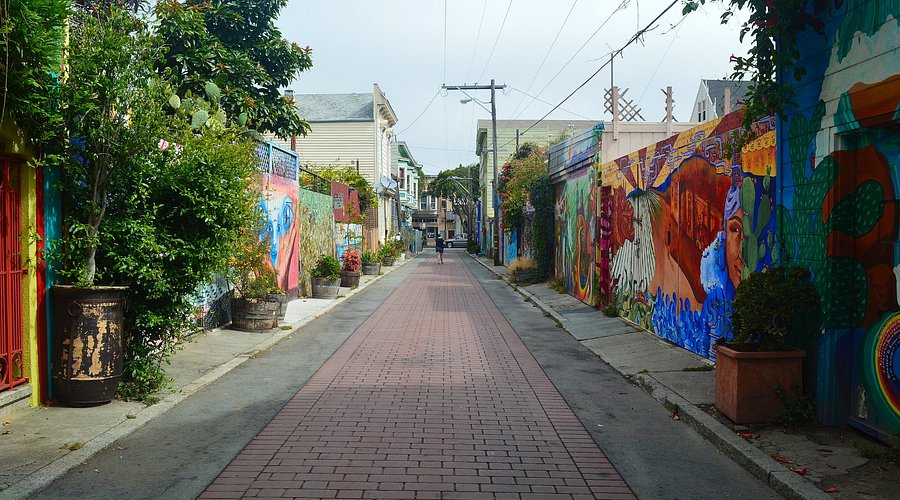
Since at least the 1980s, if you’ve wandered through San Francisco’s Mission District, you’ve likely noticed the vibrant murals and street art that color the neighborhood. From the Aztec serpent-god Quetzalcoatl in 24th & York Mini Park to the “Maestrapeace” mural on the Women’s Building facade, and the countless tags and spray-painted designs that appear overnight on shop shutters, the Mission functions as a living, evolving outdoor art gallery. Yet, few places are as richly painted or as renowned as Balmy Alley.
Located just off 24th Street, running parallel to Treat Avenue and Harrison Street between 24th and 25th, Balmy Alley has been a home for Chicano artists’ murals for nearly fifty years. These artworks draw on the deep tradition of muralismo — an artistic movement rooted in pre-Hispanic Central American cultures that surged in importance following the Mexican Revolution, both in its original countries and among Mexican communities in the U.S.
Balmy Alley’s murals cover a broad range of themes, from a tribute to El Salvadoran activist Archbishop Óscar Romero to an homage celebrating great women artists like Frida Kahlo and Georgia O’Keeffe. Some of the oldest surviving murals — including “The Primal Sea” at Garfield Pool on Harrison and 26th Street and the work “Culture Contains the Seed of Resistance that Blossoms into the Flower of Liberation” by Miranda Bergman and O’Brien Thiele — have recently been restored, allowing visitors to witness how the Mission’s unique brand of muralismo has evolved over the decades.
To visit Balmy Alley, take BART to 24th/Mission station and walk east toward Capp Street for about five and a half blocks.
Nonprofit organization Precita Eyes offers mural-led tours every weekend, showcasing 60 to 70 murals within a six- to ten-block area around Balmy Alley. Founded in 1977 by Susan and Luis Cervantes, Precita Eyes was created to make public art accessible and provide nonprofit arts education. The group was active in the Mission during Balmy Alley’s early mural boom, working alongside collectives like Mujeres Muralistas and the PLACA project, witnessing and contributing to Balmy’s growth over the years.
Tour prices are generally $20 for adults, $15 for San Francisco residents, $10 for seniors and college students, $6 for teens, and $3 for children under 12.
For a unique blend of food and art, Edible Excursions offers a three-hour Saturday tour along 24th Street, highlighting the Mission’s rich culinary scene while also taking in the Balmy murals. This experience costs $125 per person.
The 1970s were a time of upheaval in San Francisco. Indigenous activists, including the Indians of All Tribes, had occupied Alcatraz, students protested the Vietnam War, the Castro District emerged as the LGBTQIA+ capital, and fierce debates over affordable housing rocked ethnic neighborhoods like Chinatown. Marginalized groups found their voices, transforming the city’s cultural and political landscape.
Amid this, the Chicano movement gained momentum, especially in Latino neighborhoods like the Mission District. The growing pride in Chicano identity fueled a wave of colorful murals, drawing on the tradition of muralismo and San Francisco’s long history of political activism.
San Francisco’s connection to muralismo wasn’t new — Diego Rivera’s 1931 fresco Allegory of California at the Stock Exchange Lunch Club reflected anti-capitalist themes. But in the 1970s, Mission murals evolved to reflect decades of shifting conversations about Chicano identity and the experiences of Central American immigrants rebuilding their lives in the city.
In 1970, Chicana artists Patricia Rodriguez and Graciela Carrillo met at the San Francisco Art Institute and by 1974 formed Mujeres Muralistas, a collective that was groundbreaking both for featuring women artists and for introducing domestic and ecological themes to a movement often dominated by overt political messaging.
Rodriguez and Carrillo were soon joined by Venezuelan-born Consuelo Mendez and Chicana artist Irene Perez. Mujeres Muralistas launched large murals in Balmy Alley near where the founders lived, close to murals by Mia Gonzalez and Susan Kelk Cervantes that had appeared a year earlier.
Their work quickly sparked a movement to reshape politics through art. Artist Ray Patlan founded the PLACA project (named after a slang term for graffiti), which secured grants to bring dozens of artists together to create murals protesting the Reagan administration’s interventions in Central America and the struggles of refugees from Nicaragua, El Salvador, Guatemala, and Honduras.
Many PLACA murals appeared in and around Balmy Alley, cementing the location as a hub for a new chapter in both muralismo and San Francisco’s art scene. Artist René Yañez, key in founding the Mexican-American Liberation Art Front (MALAF), later helped secure more funding through the Neighborhood Arts Program to expand murals across the Mission.
Eventually, the mural movement radiated beyond Balmy Alley, inspiring similar efforts across the country that embraced more diverse and inclusive expressions of muralismo. The pioneering work of these artists has been celebrated through documentaries, books, and exhibits at institutions like the De Young Museum and SFMOMA, continuing to shape one of San Francisco’s most beloved neighborhoods.
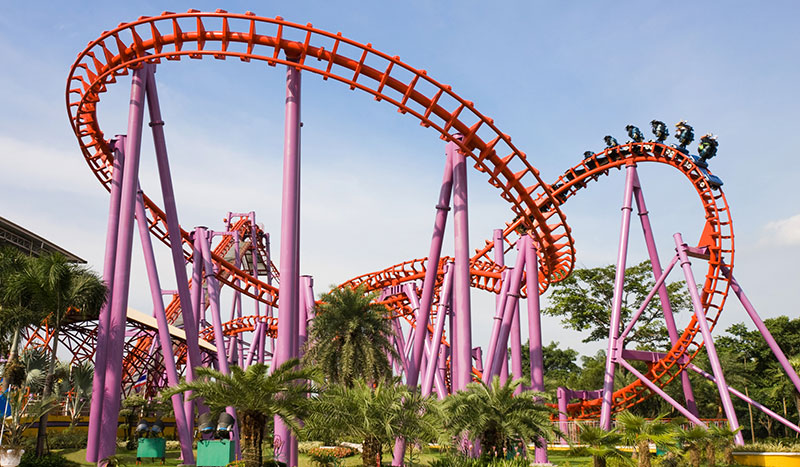
What began as a humble berry farm has blossomed into a sprawling 160-acre theme park filled with thrilling rides, live performances, and beloved Peanuts characters roaming the grounds. Knott’s Berry Farm is California’s oldest amusement park and might also claim the crown for the best food. The fried chicken dinners that put the farm on the map back in the 1930s are still served today, and the berries that started it all show up in delicious treats all around the park. Come for the roller coasters, stay for the boysenberry delights.
Walter and Cordelia Knott settled in Buena Park, California, in 1920 to farm berries. However, in 1934, Cordelia opened a fried chicken restaurant as a side venture, which quickly became famous. Visitors would sometimes wait up to three hours just to try the dinners. To entertain these hungry guests, Walter began adding attractions, and the beginnings of a theme park took shape.
By 1947, Walter had created a Ghost Town, and Knott’s Berry Farm officially became an amusement destination. Attractions such as a saloon, railroad, log ride, and roller coasters were added over time. In the 1980s, Snoopy and the Peanuts gang joined the fun, making the park even more family-friendly. The 1990s brought more thrilling rides, and the Knott family sold the park to Cedar Fair, who continues to run it today.
Tickets: Purchase daily admission and season passes online at knotts.com or at the park’s entrance. Discounts are available for active and retired military members and their immediate families.
Upgrades: Fast Lane wristbands provide priority access on select rides, while FunPix passes offer unlimited digital photos from rides and character meet-and-greets. Dining passes come in options like all-day drink refills, single meals, all-day dining (an entrée and side every 90 minutes!), and all-season dining.
Park Hours: Open daily except Christmas, with hours varying by season—some days closing as early as 5 PM, while special events like Knott’s Scary Farm run until 1 AM. Always check the official calendar before your visit.
Location: Situated in Buena Park, Orange County, Knott’s is roughly 20 minutes from John Wayne Airport and 30 minutes from LAX.
Parking: Paid daily parking is available, with season pass holders able to purchase parking as well. Complimentary one-hour parking is offered at the California Marketplace outside the park.
Knott’s Berry Farm features four themed areas: Old West Ghost Town, Camp Snoopy, Fiesta Village, and the Boardwalk. Visit knotts.com/directions for detailed maps.
The Timber Mountain Log Ride, open since 1969, takes guests up an 85-foot mountain for a classic thrill. For speed lovers, the Xcelerator coaster accelerates from 0 to 82 mph in just 2.3 seconds. Younger visitors can enjoy the Linus Launcher, simulating a flight on the Peanuts character’s blanket.
Live performances add to the park’s charm, including can-can dancing and comedy at the Calico Saloon and the high-energy Wild West Stunt Show. The Bob Baker Marionette Theater, founded in Los Angeles in 1963, presents puppetry shows in the Birdcage Theatre.
With around 36 dining options, Knott’s offers everything from gourmet berry salads (Boardwalk BBQ) and tamales (Cantina) to chili-cheese tater tots (Calico Tater Bites). Starbucks at the California Marketplace is the only location worldwide to serve boysenberry Frappuccinos. The must-try meal is at Mrs. Knott’s Chicken Dinner Restaurant, where the original 1934 recipes remain unchanged.
Thanks to Southern California’s mild climate, the park is open year-round. To avoid crowds, visit on weekdays or during school sessions. Seasonal events include the Knott’s Peanuts Celebration (January-March weekends), the Boysenberry Festival in spring, summer nighttime concerts, the spooky Knott’s Scary Farm in autumn (special ticket required), Knott’s Spooky Farm for families, and the festive Knott’s Merry Farm from November to January.
The Knott’s Berry Farm Hotel is a short five-minute walk from the gates and offers Snoopy-themed rooms, an outdoor pool, a restaurant, vacation packages, and a shuttle to Disneyland Resort, just seven miles away. Other nearby hotels include Radisson Suites Hotel Anaheim-Buena Park, Holiday Inn Buena Park, and Courtyard Anaheim Buena Park, all within a mile and featuring outdoor pools.
Walter Knott cultivated the world’s first commercially grown boysenberries—a cross between red raspberries, blackberries, and loganberries—right on the farm. This unique fruit can be found in everything from pork shawarma to kimchi and quesadillas throughout the park.
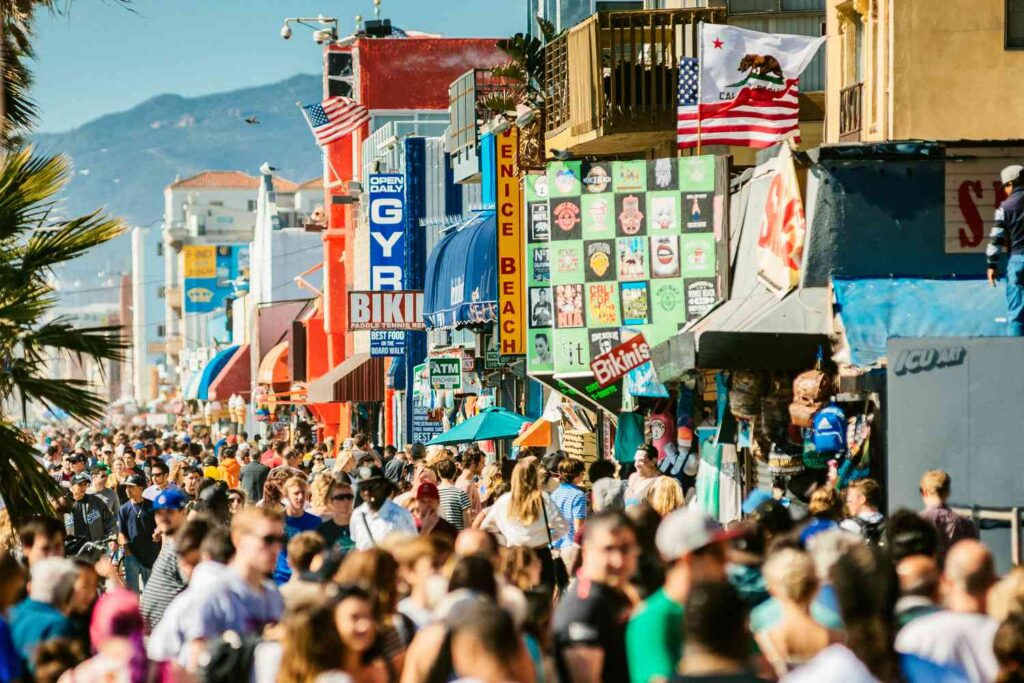
Prepare yourself for a sensory overload at Venice’s Boardwalk, a truly unique experience. Buff bodybuilders mingle with street performers and vendors selling sunglasses, string bikinis, Mexican ponchos, and cannabis. Meanwhile, cyclists and inline skaters speed along the bike path as skateboarders and graffiti artists claim their own turf.
Venice, Southern California’s iconic bohemian hotspot, owes its origins to Abbot Kinney (1850–1920). A tobacco businessman and visionary dreamer, Kinney transformed swampy, foul-smelling land into a cultural and leisure destination he named the ‘Venice of America’ in 1905 by digging canals. For nearly twenty years, visitors flocked to this ‘Coney Island on the Pacific,’ enjoying gondola rides by imported gondoliers, strolling beneath Renaissance-style arcades, and listening to Benny Goodman play in local clubs. However, Kinney’s vision eventually faded.
Venice was absorbed into Los Angeles in 1926, and by 1929 most canals were filled in and paved over. The area then fell into decline until its low rents and laid-back vibe attracted beatniks and later hippies during the 1950s and 60s. In the 1970s, Venice and Santa Monica’s Ocean Park neighborhood became known as ‘Dogtown,’ the birthplace of modern skateboarding culture.
Today, tech and entertainment investments have driven rapid gentrification, altering this once laid-back community. Rising rents have pushed out many longtime businesses, creating a divide between ‘old Venice’ and ‘new Venice.’ In 2017, the local success of Snap Inc. (Snapchat’s parent company) further fueled wealth influxes. Despite the presence of affluent newcomers alongside surfers, skaters, yogis, psychics, and performers, Venice maintains a large and longstanding houseless population, which remains woven into the neighborhood’s fabric despite city efforts to relocate them.
Murals
Venice has a rich history of street art, often caught in battles between graffiti artists and authorities. The artists prevailed, and today the beachside Venice Beach Art Walls display ever-changing graffiti and murals dating back to 1961. Explore works by renowned artists like Rip Cronk, featuring pieces such as Venice Reconstituted, tributes to Jim Morrison, and Homage to Starry Night. Nearby Abbot Kinney Boulevard hosts excellent art galleries, including the LA Louvre—a striking modern and contemporary gallery housed in a landmark building by Frederick Fisher, showcasing rotating museum-quality exhibits every five to six weeks.
Muscle Beach
Fitness enthusiasts with a flair for showmanship can work out and soak up the sun at this famous open-air gym on the boardwalk, once frequented by legends like Arnold Schwarzenegger and Franco Columbu. It’s always entertaining to stop by and watch the bodybuilders in action—they love the attention.
Venice Skatepark
Modern skateboarding was born when Angelenos drained their backyard pools during a drought in the 1970s, and Venice teens took to skating in the empty basins. Today, the 17,000-square-foot ocean-view Venice Skatepark is a hotspot for skaters of all skill levels and a great place for spectators to capture stunning photos, especially at sunset. Dare to try the bowls if you’re brave!
Saturday & Sunday Drum Circle
On weekend evenings at the beach’s end of Brooks Avenue, hundreds gather with drums, shakers, and congas to create a lively rhythm. Dancers flock to the circle, moving to the impromptu beats in a joyous, high-energy celebration that typically starts at noon and continues well into the night.
The boardwalk is quietest in the early morning and late at night, though most visitors come for the lively atmosphere. Summer weekend afternoons, especially during the drum circle, are the busiest. In off-seasons, locals often gather at nearby cafes around sunset.
The Rose perfectly blends Venice’s old and new vibes. Established in 1979 but still trendy, this airy spot serves a varied all-day menu—from sophisticated pastries to gourmet meals—catering to locals, tech workers, and creatives alike.
Hotel Erwin, near the canals and boardwalk, is a refurbished motor inn decked out in retro style with bright oranges, yellows, and greens, graffiti art photos, and comfortable sofas. Booking online secures the best rates. The hotel’s High rooftop lounge is a fantastic place to enjoy a sunset drink. Valet parking costs $42.
Venice experiences heavy traffic on busy summer weekends, especially near the beach. Instead of driving, consider parking further inland, using ride-shares, or cycling like the locals. Bike rentals are available from Venice Boardwalk Bike Rental and in nearby Santa Monica. The Expo Line train, opened in 2016, stops about 1.5 miles from Venice’s border in Santa Monica.
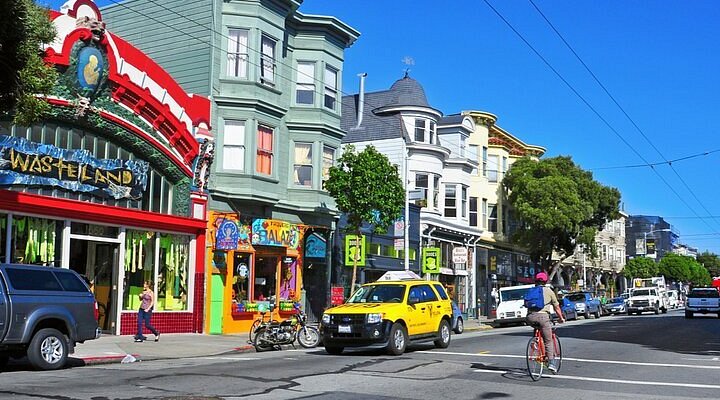
Was it the fall of 1966 or the winter of ’67? As the saying goes in the Haight, if you remember the Summer of Love, you probably weren’t really there. The fog was thick with the scents of marijuana, sandalwood incense, and burning draft cards. People spent whole days lost in trippy Grateful Dead posters, while the corner of Haight and Ashbury Streets became the epicenter of a cultural revolution. The neighborhood’s counterculture youth called themselves freaks and flower children, while San Francisco Chronicle columnist Herb Caen coined the term ‘hippies.’
But the history of Haight reaches back more than sixty years before the Summer of Love ignited. The iconic Victorian Painted Ladies survived the devastating 1906 earthquake that destroyed much of San Francisco. Yet, over the following decades, these once-beautiful single-family homes suffered during the Great Depression, were divided into apartments in World War II, and nearly lost to a planned freeway in the 1950s. Still, in this period of decline, the seeds of counterculture were already taking root.
As David Talbot explains in Season of the Witch, by the time development threatened Golden Gate Park’s Panhandle, Haight was home to a diverse, tight-knit community ready to support one another and embrace fresh ideas. Black homeowners resisting disenfranchisement, Beat poets pushed out of gentrifying North Beach, members of the queer community from the Castro, and politically active students who had taken part in Freedom Rides all found a home here. City Hall was powerless against this growing movement.
The Haight became a refuge where people found their tribe. A new generation of young artists moved into now-legendary houses still visited by rock ’n’ roll pilgrims today. The Grateful Dead’s residence at 710 Ashbury became a central hub. Nearby, the infamous Hells Angels were based at 715 Ashbury, and Janis Joplin briefly stayed a block away at 635. Joplin’s band, Big Brother and the Holding Company, lived at 1090 Page Street (now condos). Charles Manson and his “family” occupied 636 Cole for a time, while Jefferson Airplane made 2400 Fulton Street their home, with Grace Slick’s voice filling the mansion. Jimi Hendrix wrote “Red Door” inspired by his apartment at 1524A Haight Street.
Drugs like LSD, speed, and cannabis flowed freely. Young people from across the country flocked to Haight to escape mainstream life and dive into the counterculture. Many found shelter in rooming houses such as the Red Victorian (then known as Jeffrey Haight), friends’ apartments, or even in Golden Gate Park. The Diggers, a radical anarchist and performance art collective, played a vital role by offering free housing, health clinics, soup kitchens, clothing swaps, and artistic happenings—often in partnership with bands like the Grateful Dead.
This vibrant, creative scene is fondly remembered, though it had its darker sides. Journalist Joan Didion, who reported on Haight-Ashbury in 1967 for The Saturday Evening Post, didn’t find the utopia many sought. Instead, she saw a crumbling landscape of lost drug users, including a five-year-old child under the influence of LSD. Didion’s essay foreshadowed the decline into hard drugs and decay that even the most dedicated community activists and groups like the Diggers couldn’t prevent.
The neighborhood underwent gentrification during the 1980s, restoring many of its elegant homes. Today, Haight blends old and new businesses that reflect its hippie heritage and the shifting culture of tech-era San Francisco. Despite changes, echoes of the ’60s remain strong.
Places like indie bookstore Booksmith, Amoeba Music, and Magnolia Brewery, as well as outdoor hangouts like Hippie Hill and Buena Vista Park, keep the countercultural spirit alive. Annual events such as the Haight-Ashbury Street Fair celebrate this legacy. Yet, you can also experience the neighborhood’s evolution at restaurants like Alembic, known for creative dishes like jerk-spiced duck hearts, or step back further in time at Aub Zam Zam, a cash-only eatery serving jazz since 1941.
Visit Haight-Ashbury today and you’ll notice the lingering scent of cannabis near dispensaries, tie-dye fashion still popular, and ideals from the era alive in vintage rock tees at Wasteland, anarchist literature at Bound Together Book Collective, and compassionate care for bad trips at the Haight-Ashbury Free Clinic. At Haight and Cole, Joana Zegri’s 1967 Evolution Rainbow mural vividly portrays life evolving from the Pleistocene to the Age of Aquarius. What new chapter awaits the Haight is anyone’s guess.
WhatsApp us